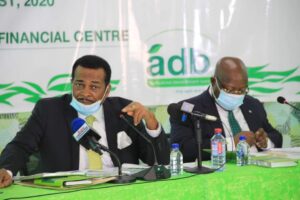Alex Bernasko, Board Chairman of the Agricultural Development Bank (ADB) has said the bank is on a growth trajectory that would see it begin to pay dividends to shareholders, especially the government, in three years.
The bank has not paid dividends for almost a decade and after two years of posting losses, 2015 and 2016, the bank returned to profitability in 2017/2018. Despite its return to profits it still is unable to pay dividends due to high Non Performing Loans on its books and the quest for capital to meet the Central Bank’s request of increased stated capital.
Now the bank has met the regulator’s directive, put in place a five-year strategy to return to quality growth backed by an agric-focused loan book of at least 50 percent and a plan to recover a huge chunk of these bad means it is more than confident to pay dividends by the end of 2023.
“In three years we can pay dividends. We have about GH¢600million in non-performing loans but some of the debtors come in to restructure their facilities and are paying but others are taking us through the legal process and even with judgement disposing off these collaterals is a bit of a challenge but all is well. So far we have judgement valued at almost GH¢300million.
Also, we made a loss of GH¢100million in 2015 and GH¢80million in 2016 but since then we have restructured the bank, paying more attention to corporate governance and we are competing well in the industry with increasing market share and I believe we are on the right track. COVID-19 has turned everything upside down but we are looking at areas to sustain growth,” he said at the bank’s annual general meeting.
He added that with the drive to expand digitally, the bank is well positioned to propel agriculture into the 21stcentury while supporting government’s agric and industry-focused programmes such as Planting for Food and Jobs (PFJ) and One District, One Factory (1D1F).
Performance
ADB posted a profit of GH¢14.8million compared to GHS5.9million in 2018 occasioning a return on equity and return on assets of 1.87% and 0.32% as against 0.92% and 0.16% in that order respectively.
Apart from the cost to income ratio which increased over the period due mainly to lower than expected revenue generation, most of the bank’s performance and liquidity indicators pointed in a positive direction. The size of the balance sheet experienced an appreciable growth over the year from GH¢3.5billion in 2018 to GH¢4.6billion in 2019 (27%) bolstered in part by its improved holdings in investment securities in line with its strategic objectives.
There was an expansion of 37% in net loan assets from GH¢1.1billion in 2018 to GH¢1.5billion in 2019 yet a marked reduction in the NPL ratio and a 31.2% growth in deposits from GH¢2.5billion in 2018 to GH¢3.4billion in 2019.

By the end of 2019, the capital adequacy ratio and the Basel Committee inspired capital requirement directive were 16.5% and 14.5% respectively, both above the minimum regulatory limit.
The reviewed strategic plan which spans the period 2020 to 2022 provides, among other things, the guidance to influence the Bank’s current operating model and the changes that will ensure its sustainability and growth. KPIs and metrics for their measurement are being developed into effective dashboards for monitoring and evaluation.
Managing Director, Dr. John Kofi Mensah, noted that the COVID-19 pandemic has introduced new dynamics to competition in the banking sector and elsewhere. “We remain resolute to carry through our reviewed strategic plan (2020 – 2022). We are strictly adhering to all the safety protocols spelt out by the Ghana Health Service to protect our staff and customers alike and indeed all our partners from the perilous Corona virus.”
This year, he explained that the bank’s focus would be to optimize its digitization process, position the bank as the bank of choice especially for agribusiness, improve its deposit mobilization drive and customer experience and introduce new consumer finance products for customers.










